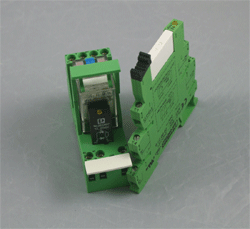Using general-purpose relays to drive inductive loads should not sacrifice their size, cost, and functional advantages
BY BRUCE DESMOND
Phoenix Contact
Middletown, PA
http://www.phoenixcon.com/
One of the most frustrating challenges for control engineers and specialists is the potential early failure of interposing or interfacing relays used to drive inductive loads. This is especially true of general-purpose “ice cube” and increasingly popular pluggable compact relays, even when the relays appear to be sufficiently oversized to power low-amperage loads such as small motors, dc solenoids, and contactor coils.

By using proper contact protection circuitry, modern interface relays as slim as 6.2 mm can be used to drive 6-A, 250-V loads.
Why does a relay with a continuous current rating of 6 A fail prematurely when driving a dc solenoid with a current requirement of 1 A or less? Why can’t dc-13 and ac-15 values be used for the proper specification of relays? How can these problems be avoided? Is it really necessary to sacrifice the size, cost, and functional advantages of general-purpose relays when driving inductive loads?
If you find yourself asking questions like these or dealing with the frustration that typically follows, you are among the many that have battled those ever-present “inductive-load demons.” But this is a battle that can be easily won, provided you are armed with the correct knowledge tools and use them to control the inherent problems associated with these types of loads within a control system.
The problems
General-purpose relays are typically designed to drive resistive loads, not inductive loads. This is why electromechanical life ratings are published for ohmic loads and not inductive loads.
Unlike resistive loads, inductive loads love power, and they will do everything they can to hold on to it. The unpleasant result of this power hunger is inductive kickback, and it has a devastating effect on the contact life of most general-purpose relays. This is true of both ac and dc inductive loads, although the inductive kickback is far worse with dc loads due to the constant current characteristic of dc power.
How bad is the kickback? A 24-Vdc solenoid with a current consumption as low as a quarter of an amp will create a negative inductive kickback of more than 300 V.
When you consider that this 300-V inductive kickback is produced each time the relay contacts “break,” then it becomes far more understandable why many general-purpose relays fail prematurely.
Adding to the frustration of inductive loads is the confusion over ac-15 and dc-13 load ratings. Although these inductive ratings were designed to assist control engineers and designers in selecting the correct relay for the application, these ratings are not always reliable, especially in common control applications.
The switching capacity test in accordance with DIN VDE 0660 is only 6,060 cycles with these ratings, which helps highlight the theoretical relevance of such load ratings when trying to specify general-purpose relays. In contrast, switching cycles in most real-world applications easily exceed these levels, and thus highlights the theoretical relevance of such load ratings when trying to specify general-purpose relays.
Fixing the problems
Perhaps the most common practice in battling these load demons is the deliberate oversizing of the general-purpose relay. This is a very sound practice because the larger the relay, the wider the contact surface area, the greater the contact gap, and therefore the longer the life expectancy.

Larger relays equate to larger contact surface area and a wider contact gap, but at the expense of larger form factors.
This oversizing can also be a very effective practice, especially with ac inductive loads. Unfortunately, this is far less effective with dc inductive loads because of their aforementioned problems.
At best, this practice simply delays the inevitable, and often by very little. In addition, the oversizing of general-purpose relays leads to consuming more valuable space in control cabinets, while adding unnecessary cost to a system which will still experience premature relay failure.
The only way to truly defeat the inductive-load demons is with surge-suppression protection from the inductive load that is causing the problems. This is a relatively simple and inexpensive fix that will tame the worst of the inductive-load demons.
Contact protection circuits
Remember the 24-Vdc solenoid example cited earlier? A simple contact protection circuit consisting of a type 1N4004 free-wheeling diode will remove all of the negative kickback generated from the dc solenoid.
Unlike the temporary (and unreliable) fix of trying to oversize a general-purpose relay so it will last a little longer in the face of inductive kickback abuse, a contact protection circuit will snuff out the inductive kickback and contribute to a far more reliable control system. In addition, a simple contact protection circuit/free-wheeling diode will allow the freedom of using a general-purpose relay that is truly sized for the load-handling requirements of the device.
This practice creates a control system which properly addresses inductive kickback problems while enabling the use of today’s advanced pluggable compact relay.

This scope capture/screenshot demonstrates the 320-V, negative inductive kickback created by a ¼-A, 24-Vdc solenoid. ■
Get more information on circuit protection at http://electronicproducts-com-develop.go-vip.net/passives.asp
Advertisement
Learn more about Phoenix Contact





